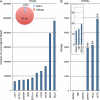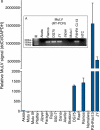Detection of murine leukemia virus in the Epstein-Barr virus-positive human B-cell line JY, using a computational RNA-Seq-based exogenous agent detection pipeline, PARSES
- PMID: 22238296
- PMCID: PMC3302299
- DOI: 10.1128/JVI.06717-11
Detection of murine leukemia virus in the Epstein-Barr virus-positive human B-cell line JY, using a computational RNA-Seq-based exogenous agent detection pipeline, PARSES
Abstract
Many cell lines commonly used for biological studies have been found to harbor exogenous agents such as the human tumor viruses Epstein-Barr virus (EBV) and human papillomavirus. Nevertheless, broad-based, unbiased approaches to globally assess the presence of ectopic organisms within cell model systems have not previously been available. We reasoned that high-throughput sequencing should provide unparalleled insights into the microbiomes of tissue culture cell systems. Here we have used our RNA-seq analysis pipeline, PARSES (Pipeline for Analysis of RNA-Seq Exogenous Sequences), to investigate the presence of ectopic organisms within two EBV-positive B-cell lines commonly used by EBV researchers. Sequencing data sets from both the Akata and JY B-cell lines were found to contain reads for EBV, and the JY data set was found to also contain reads from the murine leukemia virus (MuLV). Further investigation revealed that MuLV transcription in JY cells is highly active. We also identified a number of MuLV alternative splicing events, and we uncovered evidence of APOBEC3G (apolipoprotein B mRNA-editing enzyme, catalytic polypeptide-like 3G)-dependent DNA editing. Finally, reverse transcription-PCR analysis showed the presence of MuLV in three other human B-cell lines (DG75, Ramos, and P3HR1 Cl.13) commonly used by investigators in the Epstein-Barr virus field. We believe that a thorough examination of tissue culture microbiomes using RNA-seq/PARSES-like approaches is critical for the appropriate utilization of these systems in biological studies.
Figures






References
-
- Coco JR, Flemington EK, Taylor CM. 2011. PARSES: a Pipeline for Analysis of RNA-Seq Exogenous Sequences, p 196–200 Abstr. ISCA 3rd Int. Conf. Bioinform. Comput. Biol., New Orleans, LA
-
- Dominissini D, Moshitch-Moshkovitz S, Amariglio N, Rechavi G. Adenosine-to-inosine RNA editing meets cancer. Carcinogenesis 32:1569–1577 - PubMed
-
- Esnault C, et al. 2005. APOBEC3G cytidine deaminase inhibits retrotransposition of endogenous retroviruses. Nature 433:430–433 - PubMed
-
- Harris RS, et al. 2003. DNA deamination mediates innate immunity to retroviral infection. Cell 113:803–809 - PubMed
Publication types
MeSH terms
Substances
Grants and funding
LinkOut - more resources
Full Text Sources
Other Literature Sources
Research Materials

